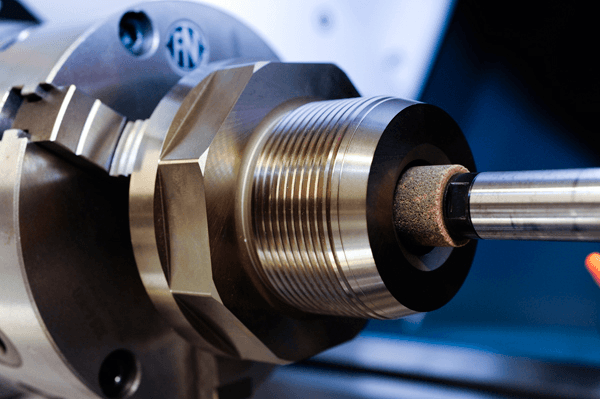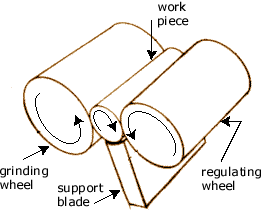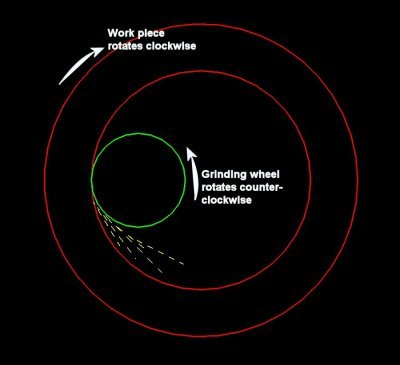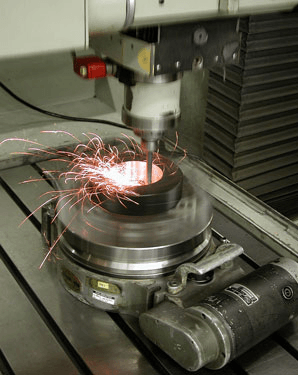Precision Grinding Services Information

Grinding is a process that involves removing small thicknesses of materials using an abrasive material. Grinding is used when more precise dimensions and surfaces are required than can be achieved by other machining processes. For grinding to be effective, the work piece must be a hard material like metal, ceramic, or mineral. Precision grinding services are contracted from a "job shop" or "machine shop" when in-house capabilities are not available or are inadequate. The service provider receives the rough parts along with the required finish and dimensions. The precision grinder completes the work and returns the finished parts to the customer.
Precision Grinding Capabilities
Precision grinding services perform operations such as centerless grinding, creep feed grinding, double-disc grinding, internal grinding, external grinding, jig grinding, surface grinding, and thread grinding. Precision grinding services that perform other types of grinding operations are also available.
Centerless grinding is used for parts without centers or places to hold the part. It is an OD machining operation in which an abrasive wheel grinds metal from a bar’s surface while a regulating wheel forces the bar against the grinding wheel. The part will rotate between the regulating wheel and the grinder. The regulating wheel is tacky in order to grip the part and spins in the same direction as the grinder. This is a very fast process as the parts are being continuously fed into one end and out the other end.

Image Credit: efunda
Creep feed grinding is a type of plunge grinding that uses specialized grinding equipment. It is used to produce slots or intricate forms in difficult-to-grind materials such as pre-hardened tool steels and high-temperature nickel-based aerospace alloys. The grinding wheel is fed into the work at very slow rates. Creep feed grinding has two advantages over machining including being able to work on materials that are difficult and expensive to shape and allowing easy modification of the form on the grinding wheel to enable quick design changes and changeovers.
Disc grinding and double-disc grinding use a large wheel to produce flat, parallel parts for high-volume production. Double-disc grinders are machines with two independent grinding wheels. With double-disc grinding, the work passes between the faces of the two grinding wheels. Single-disc grinders exist, but are less common than double-disc devices. In a single-disc machine, the grinding wheel is usually mounted to a vertical spindle.
Video Credit: tciprecisionmetals / CC BY 3.0
Internal grinding or ID grinding is used to grind the inner diameter (ID) of holes. It uses a small high-speed grinding wheel on tubular parts. The high speed is used to maintain the proper surface speed. The parts are held in place with a collet or chuck.

Image Credit: The Virtual Machine Shop
External grinding or OD grinding is used to grind the outer diameter (OD) of cylindrical parts. The grinding is preformed between centers in the workpiece. The work piece and the grinding wheel rotate in the same direction so the surface of the work piece and the grinding wheel are moving in opposite directions at the point of contact.
Jig grinding uses very precise machines for locating and generating very accurate holes, contours, and surfaces to tolerances of .0001" or less. They can also be used for a variety of difficult grinding tasks such as blind holes, pockets, and to add reliefs.

Image Credit: Global Plastic Injection Molding
Superabrasive grinding uses grinding machines made from extra hard materials such as diamond, cubic boron nitride (CBN), and borazon. Often a superabrasive grinding machine can replace two-or-more standard process because they allow for closer tolerance machining and less tool wear. This results in overall cost savings and higher quality machining.
Surface grinding mounts the workpiece to a table for back and forth feeding under the grinding wheel. They produce flat and parallel surfaces. The grinding wheel is mounted to a horizontal spindle and the work is ground with the outside diameter of the wheel
Thread grinding is used to produce lead screws, ball screws, and worms. Thread grinding is a metal removing process preformed with a single-point contact or formed wheels.
Machining Services
Precision grinding services differ in terms of additional services and material capabilities. There are seven parameters for additional services:
- Field machining- Also known as on-site machining, the vendor has the ability to travel to the work site and preform the service. This may be done on machines that are large and impractical to move.
- CAD/CAM support- Computer aided design or drafting (CAD) is used to design parts quickly and accurately. Computer aided manufacturing (CAM) is used to fabricate products directly from CAD outputs. The service provider must be able to receive solid-model files electronically and/or use those files for creation of a part.
- Design assistance- Design assistance is a service provided by suppliers who can assist with concepts, manufacturing costs, techniques, and material considerations.
- Just-in-time (JIT) delivery- JIT manufacturing is designed to reduce inventory maintenance by producing the parts as needed.
- Rapid prototyping- Prototyping creates a small number of functional representative parts. Rapid prototyping is a service which allows for a small quantity to be made very quickly.
- Low-volume production- Suppliers provide low-volume production.
-
High-volume production- Suppliers provide high-volume production.
Materials
With regard to material capabilities, precision grinding services often work with metals such as aluminum, brass, bronze, cast iron, copper, hardened metals, nickel, nickel alloys, precious metals, steel, stainless steel, steel alloys, and titanium. Precision grinding services may also work with non-metal materials such as carbides, ceramics, composites, natural and synthetic diamond, glass, glass ceramics, quartz, sapphire, and ruby.
Regulatory Standards
They adhere to a variety of certifications, regulatory requirements, and quality standards. Precision grinding services follow several main specifications.
International Standards Organization (ISO): ISO 9001:2000, ISO 13485:2003, ISO 14001, and ISO/TS 16949:2002. AS 9000, AS 9100, and QS-9000 are industry-specific quality standards that are based on ISO 9001. Both AS 9000 and AS 9001 define quality management system (QMS) requirements for suppliers to the aerospace industry. QS-9000 is a quality standard for suppliers of Daimler Chrysler Corporation, Ford Motor Company, and General Motors Corporation.
Some precision grinding services are registered with the Food and Drug Administration (FDA), or comply with U.S. military specifications (MIL-SPEC). Others meet internal company specifications or requirements from original equipment manufacturers (OEM).
Resources
- Alabama
- Arizona
- California
- Colorado
- Connecticut
- Delaware
- Florida
- Georgia
- Iowa
- Illinois
- Indiana
- Kansas
- Kentucky
- Louisiana
- Massachusetts
- Maryland
- Maine
- Michigan
- Minnesota
- Missouri
- Mississippi
- North Carolina
- New Hampshire
- New Jersey
- Nevada
- New York
- Ohio
- Oklahoma
- Oregon
- Pennsylvania
- Rhode Island
- South Carolina
- Tennessee
- Texas
- Utah
- Virginia
- Vermont
- Washington
- Wisconsin
- West Virginia
- Aluminum
- Brass
- Bronze
- CAD / CAM Support
- Canada Only
- Carbide
- Cast Iron
- Centerless Grinding
- Ceramics
- Composites
- Copper
- Creep Feed Grinding
- Design Assistance
- Diamond / PCD
- Double-disc Grinding
- East Asia / Pacific Only
- Europe Only
- Glass
- Glass Ceramics
- Hardened Metals
- High Volume Production
- ID / Internal Grinding
- Jig Grinding
- Just-in-Time Delivery
- Low Volume Production
- Midwest US Only
- Nickel / Nickel Alloys
- North America
- Northeast US Only
- Northwest US Only
- OD / External Grinding
- Precious Metals
- Prototype Services
- Quartz
- Sapphire / Ruby
- Southern US Only
- Southwest US Only
- Stainless Steel
- Steel / Steel Alloys
- Superabrasive Grinding
- Surface Grinding
- Thread Grinding
- Titanium
- United States Only
